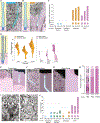Ultrastructural differences impact cilia shape and external exposure across cell classes in the visual cortex
- PMID: 38749425
- PMCID: PMC11217952
- DOI: 10.1016/j.cub.2024.04.043
Ultrastructural differences impact cilia shape and external exposure across cell classes in the visual cortex
Abstract
A primary cilium is a membrane-bound extension from the cell surface that contains receptors for perceiving and transmitting signals that modulate cell state and activity. Primary cilia in the brain are less accessible than cilia on cultured cells or epithelial tissues because in the brain they protrude into a deep, dense network of glial and neuronal processes. Here, we investigated cilia frequency, internal structure, shape, and position in large, high-resolution transmission electron microscopy volumes of mouse primary visual cortex. Cilia extended from the cell bodies of nearly all excitatory and inhibitory neurons, astrocytes, and oligodendrocyte precursor cells (OPCs) but were absent from oligodendrocytes and microglia. Ultrastructural comparisons revealed that the base of the cilium and the microtubule organization differed between neurons and glia. Investigating cilia-proximal features revealed that many cilia were directly adjacent to synapses, suggesting that cilia are poised to encounter locally released signaling molecules. Our analysis indicated that synapse proximity is likely due to random encounters in the neuropil, with no evidence that cilia modulate synapse activity as would be expected in tetrapartite synapses. The observed cell class differences in proximity to synapses were largely due to differences in external cilia length. Many key structural features that differed between neuronal and glial cilia influenced both cilium placement and shape and, thus, exposure to processes and synapses outside the cilium. Together, the ultrastructure both within and around neuronal and glial cilia suggest differences in cilia formation and function across cell types in the brain.
Keywords: astrocyte; axoneme; centrosome; cilia; ciliary pocket; electron microscopy; neuronal cilia; oligodendrocyte precursor cell; transition zone.
Copyright © 2024 The Author(s). Published by Elsevier Inc. All rights reserved.
Conflict of interest statement
Declaration of interests The authors have no competing financial interests to declare.
Figures







Update of
-
Nanometer-scale views of visual cortex reveal anatomical features of primary cilia poised to detect synaptic spillover.bioRxiv [Preprint]. 2023 Nov 6:2023.10.31.564838. doi: 10.1101/2023.10.31.564838. bioRxiv. 2023. Update in: Curr Biol. 2024 Jun 3;34(11):2418-2433.e4. doi: 10.1016/j.cub.2024.04.043. PMID: 37961618 Free PMC article. Updated. Preprint.
References
-
- Higginbotham H, Eom T-Y, Mariani LE, Bachleda A, Hirt J, Gukassyan V, Cusack CL, Lai C, Caspary T, and Anton ES (2012). Arl13b in Primary Cilia Regulates the Migration and Placement of Interneurons in the Developing Cerebral Cortex. Dev. Cell 23, 925–938. 10.1016/j.devcel.2012.09.019. - DOI - PMC - PubMed
-
- Koemeter-Cox AI, Sherwood TW, Green JA, Steiner RA, Berbari NF, Yoder BK, Kauffman AS, Monsma PC, Brown A, Askwith CC, and Mykytyn K (2014). Primary cilia enhance kisspeptin receptor signaling on gonadotropin-releasing hormone neurons. Proc. Natl. Acad. Sci. USA 111, 10335–10340. 10.1073/pnas.1403286111. - DOI - PMC - PubMed
Publication types
MeSH terms
Grants and funding
LinkOut - more resources
Full Text Sources
Molecular Biology Databases

